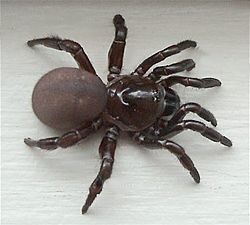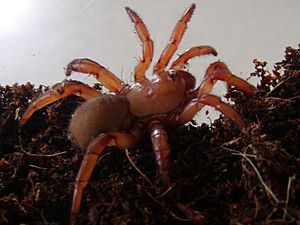Trapdoor spider facts for kids
Quick facts for kids Trapdoor spider |
|
|---|---|
 |
|
| Ummidia sp. | |
| Scientific classification | |
| Kingdom: | |
| Phylum: | |
| Class: | |
| Order: | |
| Suborder: |
Mygalomorphae
|
| Superfamily: |
Ctenizoidea
|
| Family: |
Ctenizidae
Thorell, 1887
|
| Genera | |
|
See text. |
|
| Diversity | |
| 9 genera, c. 120 species | |
 |
|
Trapdoor Spiders are fascinating creatures that belong to the spider family Ctenizidae. They are famous for building amazing homes in the ground. These homes have a special "trapdoor" that helps them hide and catch their food. Imagine a secret door in the forest floor!
Trapdoor spiders are skilled builders. They dig a small burrow, which is like a tunnel, in the dirt. Then, they cover the entrance with a lid made of soil, plants, and silk. This lid acts like a secret door. It blends in perfectly with the ground around it, making it very hard for other animals to spot.
Contents
What Are Trapdoor Spiders?
Trapdoor spiders are a type of spider. They are often quite stocky and hairy. There are about 120 different kinds, or species, of trapdoor spiders in the Ctenizidae family. They live in many parts of the world, often in warmer climates.
These spiders are part of a group called Mygalomorphae. This group includes other large spiders like tarantulas. Trapdoor spiders are known for their strong fangs and their unique way of life underground.
Their Amazing Trapdoor Home
The trapdoor is the most special part of a trapdoor spider's life. The spider builds its burrow by digging a tunnel in the soil. It lines the tunnel with silk to make it strong and cozy. The trapdoor itself is a masterpiece of camouflage.
The spider uses silk, soil, and bits of plants to create a lid that fits perfectly over the burrow's opening. It's like a secret hatch! The trapdoor is hinged with silk, so the spider can open and close it easily. This clever door helps the spider stay safe from predators and also helps it catch its meals.
Hunting Like a Pro
Trapdoor spiders are expert hunters. They spend most of their time inside their burrow, waiting patiently. They often hold onto the trapdoor with their legs. When an unsuspecting insect, like a beetle or a cricket, walks by, the spider feels the vibrations.
Suddenly, the spider bursts out of its burrow, grabs its prey, and quickly pulls it inside. Then, it slams the trapdoor shut! This whole process happens incredibly fast. It's a surprise attack that works almost every time.
Life in the Burrow
Trapdoor spiders live most of their lives in their burrows. They are mostly active at night. Some trapdoor spiders can live for a very long time, even up to 20 years! As they grow, they shed their old skin, a process called molting. They do this inside their safe burrow.
Reproduction and Life Cycle
When it's time to have babies, the male spider leaves his burrow to find a female. After they mate, the female lays her eggs inside her burrow. She protects the eggs until they hatch. Once the baby spiders are big enough, they leave their mother's burrow to dig their own tiny homes. This starts their own life cycle of building, hunting, and growing.


